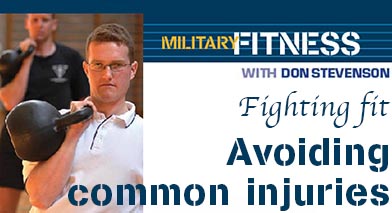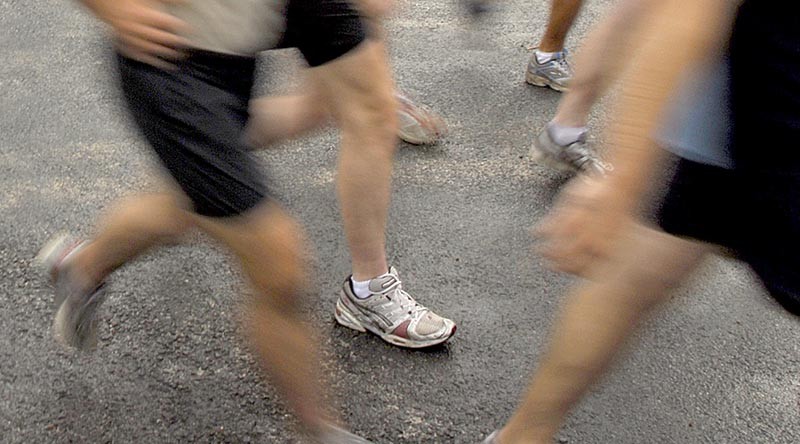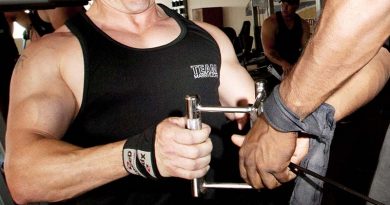Military Fitness – Part 8


Let’s face it, the military is a high-risk job, even when you aren’t deployed. Long hours and hard physical work can take their toll and often lead to muscle, bone and joint injuries.
While some injuries, such as broken bones from falls, can’t be prevented through prior physical conditioning, the risk of developing several common overuse injuries can be reduced with proper physical training before engaging in military training and operations.
In this instalment, we’ll look at three injuries common to military personnel and look at the training you should do to avoid these annoying or even career-ending injuries.
In a future instalment, we’ll look at specific strategies for maintaining your fitness if you are unlucky enough to get hurt and have to work around an injury.
Number 1 – Shin Splints
One of the most common requests I have is for a program to develop fitness while suffering from shin splints or other leg pain. Of course the best way to work around shin splints is to avoid them in the first place!
Shin splints normally occur when someone who hasn’t run much for a few months or years begins to pound the pavement in preparation for a fitness test or because they are about to join the defence force.
‘Shin splints’ is a blanket term for a number of painful conditions and you should always get your condition properly diagnosed by a doctor or physio.
However, from a fitness/training perspective the recommendations are all pretty much the same.
Avoiding shin splints
Build up slowly. If you haven’t run for a while, don’t start doing 5km or 10km every day.
Run 3 to 5km two or three times a week and increase your volume steadily over four to six weeks.
Get new shoes. Even if your runners look fine, if they are more than 12 months old, or you wear them all the time, the cushioning will have compressed and they won’t be absorbing the shock of landing on hard surfaces as well as they used to.
Go to a reputable sports-shoe store and ask to try on a few different pairs of shoes.
If possible, take a few pairs out for a run.
If you have flat feet or orthotics, make sure your shoes are suitable for your foot type.
Run mostly on soft surfaces. The human body really wasn’t designed to run long distances on concrete.
Try to do most of your running over grassy areas without too many trip hazards.
Limit your total running distance. You don’t have to run to develop good fitness and, if you have feet issues, old injuries or you are heavier than average, you should aim to limit your weekly running and develop your fitness through Crossfit training, kettlebell workouts or alternatives such as rowing.
Number 2 – Lower Back Pain
It amazes me that despite the amount of heavy lifting and pack marching that is part and parcel of military life that so little time is devoted to lower-back strengthening in PT sessions.
A strong and fatigue-resistant back is your best defence against both acute lower back injuries and chronic pain.
To strengthen your back, I suggest that heavy deadlifting should be incorporated into every fitness program.
The deadlift is the number one exercise for developing posterior chain and core strength and its benefits extend well beyond the lower back, to the legs, arms and grip.
Add three sets of five reps of deadlifts to your weights workouts and your lower back will thank you!
For developing endurance in the lower back, kettlebell swings are my first choice.
Like the deadlift, the kettlebell swing gives you a great return on your time as they develop lower-back endurance, leg power and cardio fitness all in one hit.
Throw them into your circuits or perform multiple sets of 20-50 reps with short breaks between sets.
Balance your lower back training with some odd-object lifting for all-round core strength, and some ab work, and chances are you’ll avoid chronic lower-back pain long after everyone else is hobbling around to the doctor.
Number 3 – Shoulder Injuries
Shoulder injuries in military personnel are often a result of an overemphasis on chest training (whether push-ups or excessive bench pressing), a lack of back work to balance the chest work and poor shoulder flexibility.
To develop strong, stable and healthy shoulders, try the following:
- Turkish get up with a dumbbell or kettlebell – this is an ideal prehabilitation exercise that strengthens all of the small muscles that stabilise the shoulder during primary pushing and pulling exercises.
- Balance pushing with pulling – if you are working on your bench-press or push-up numbers that’s fine, just don’t forget to add an equal or greater amount of pulling work such as chin-ups and seated rows so that your chest doesn’t overpower your back and you end up with a tight shoulder girdle.
- Stretch! – stretch your shoulders and chest after each upper-body workout and aim to develop your flexibility to the point where you can perform proper overhead squats with a light bar or broomstick.
.
.

.
.






